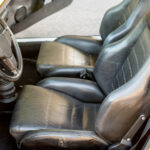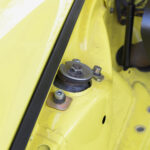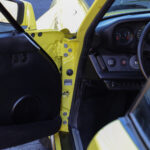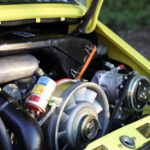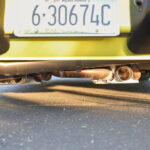
Revo Model Summary
The first Porsche road car to have turbo charging, the "930" 911 Turbo Carrera was first introduced in 1974, and arrived on US shores in '76. Loud, lairy, and with (at the time) otherworldly performance, it is a benchmark car in automotive history. The 930 underwent many changes through it's life cycle, with increased displacement (3.0 to 3.3L), cooling (intercooler added), gear ratios (4 became 5 speeds), suspension stiffness, braking and weight. The final iteration in 1989 was quite different in manners if not looks from the early ('76) example shown here.


A golden evening light settled across the fields and mountains of Montana as we looked for a place to shoot photos with the owner of this 1976 Porsche 911 Turbo Carrera. Although the sun was still high, the light was diffused by both the fresh cut wheat billowing behind harvesting combines, and the remnants of distant forest fires, creating a golden yellow glow. As we turned between two fields of winter wheat, the road unfolded in front of us in an arrow straight line to the horizon. I asked, “when does the boost kick in?” The answer was audible, but not vocal. It started with the mechanical clatter of an air cooled Porsche engine near idle, and ended with a spine tingling wail of induction, boost, and exhaust. The change was sudden, and the result was mythical.
I have no idea if we were actually going fast. It matters not. Although it was the fastest production road car on offer at its introduction, today the "930" 911 Turbo Carrera is no longer about raw data or statistics. It is a car defined by myth and legend. The 930 quickly built a reputation as widow maker, fueled by tremendous boost, lack of electronic aids, and rear drive/rear engine characteristics that caught many a novice unaware. It is an alluring shape, purposeful and now iconic, if not sensual like an Italian classic. And of course the sound is like none other. An air cooled flat six that chatters away urgently but quietly, and then suddenly screams through its curved plumbing like some sinister trumpet. These otherworldly traits can best be personified by two creatures from ancient mythology. Both were creatures who meant no harm, but were undoubtedly dangerous if ignored. The first that comes to mind is the banshee of Irish folklore, who’s keening wail is a harbinger of danger to come. The second, the lesser known Weibe Frauen of southern German and Austrian mountain town folklore. The Weibe Frauen were elven mountain women with golden yellow hair, often portrayed in filtered sunlight. They could offer travelers advice and aid, but could be vengeful if not treated with due accord.

Shifting from mythology to history, in 1974 the new “930” 911 Turbo Carrerra was introduced in Europe by Porsche. At the time, turbo charging was not new to the automaker. It had been utilizing turbos to make gaudy amounts of power in its race cars with great success for several years. However, the 911 Turbo Carrera, which first came to America in 1976, was a first foray into turbo charged road cars. They are now ubiquitous, but back then it was exotic.
As is common throughout its history, Porsche continually updated all aspects of the 930 Turbo throughout the life cycle.



The 930 was first offered in the United States from ‘76 to ‘79, with the first meaningful update arriving in ‘78. The Turbo was again offered starting in 1985, this time without the Carrerra moniker, and with the addition of mechanical fuel injection, among other incremental updates. As a 1976 car (and an early one at that with a November of ‘75 build date), the example listed here is period correct, equipped with a 3.0 liter air cooled flat six, no intercooler, and a 4 speed gearbox which was selected by Porsche over the 5 speed in the RS Carrera for its robustness in the face of the tremendous torque applied. Through it's life the 930 would gain displacement to 3.3L, get an added gear ratio with the introduction of the G50 in '89, gain an intercooler (first on a production road car?), stiffer spring ratios, stiffer roll bars, and bigger brakes.
This car was delivered with a very unusual combination of options and color. The first owner was clearly interested in maximizing performance, selecting all of the sport options and deleting the sunroof from the factory. The sport options included limited slip differential (220), and dual sport seats (409). The Turbo stripes package (393) was also on the original build ticket. Other options included 1.5 hp starter (497), and Pirelli tires. It was delivered with “Light Yellow - B6, #114” paint, the same color it now wears in a fresh coat. The owner's research indicates that this car is 1 of 18 US market cars in Light Yellow, and 1 of 3 delivered in that color without sunroof. It is an unusual color to go along with the unusual options, making for a very rare build.
The owner purchased this car in 2014, and immediately embarked on an extensive, multi-year and six figure restoration. The car was fully rebuilt from the ground up, and presents in beautiful looking and driving condition.

Modifications include:
- Non-numbers matching 930/50 ROW (rest of world) motor (the 930/50 is a 3.0 liter unit correct for the ‘75 and ‘76 Turbos sold outside of the United States), featuring a rebuilt top end and Porsche 964 cams;
- Rebuilt K27 turbo by renowned 930 exhaust specialist RarlyL8 Motorsports
- "Street" exhaust muffler by RarlyL8
- Merged type heat exchangers by RarlyL8
You can find further information on RarlyL8 products [pronounced, rarely late] here: RarlyL8 Motorsports
Other parts addressed during the restoration include:
- Rebuilt 4 speed 930/30 transmission (numbers matching)
- Refinished stock wheels by Harvey Weidman, matching date stamp, 7x15 and 8x15
- New Pirelli CN36 Tires, 175/70-15 and 215/50-15
- Trim Re-anodized by Shaun at Tru6
- Calipers restored by PMB
- New aftermarket air conditioning system
- New front trunk carpeting/upholstery
- New front windshield
- New battery
- Radio delete; Rear wiper delete

A few additional items of note: a keen eye may have observed that 1) the dashboard has a speaker grill, this was an error by the restoration shop; and 2) the under hood light is missing.
Please enjoy more pics of this mythical figure of the automotive universe, below. If you would like more information, to feature or to sell your car on Revo please contact us at info@revogarage.com.












































